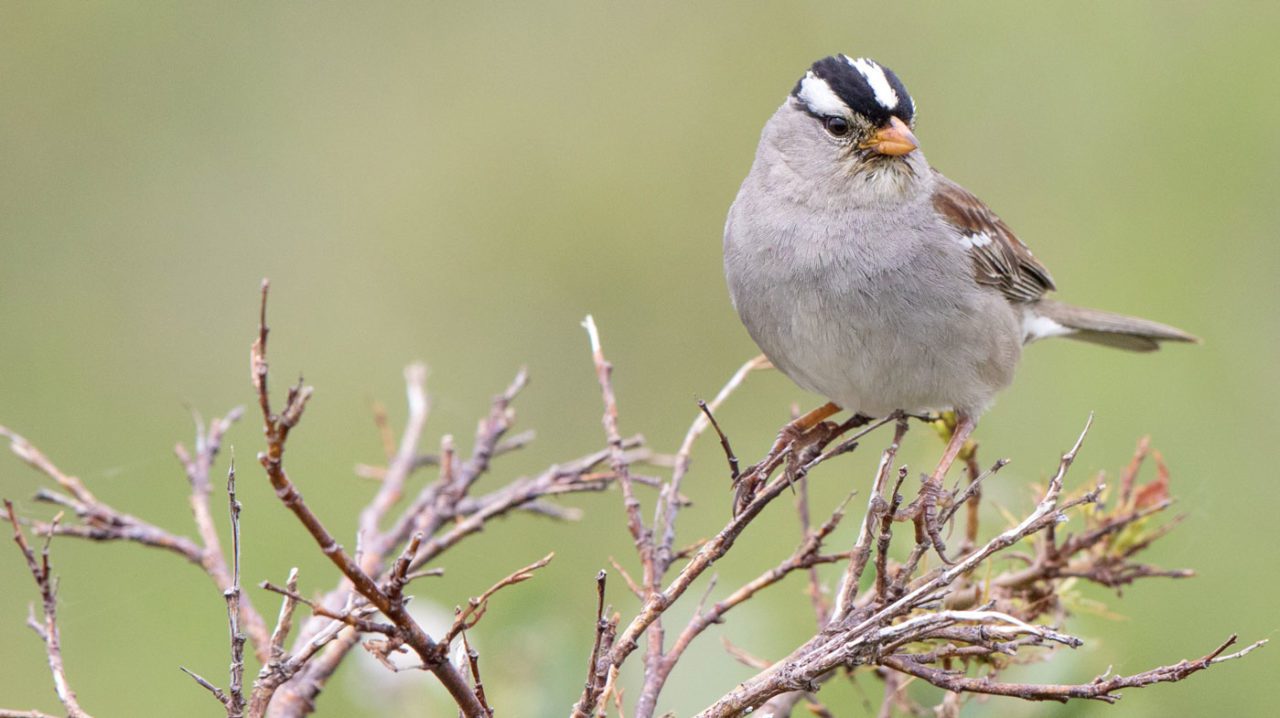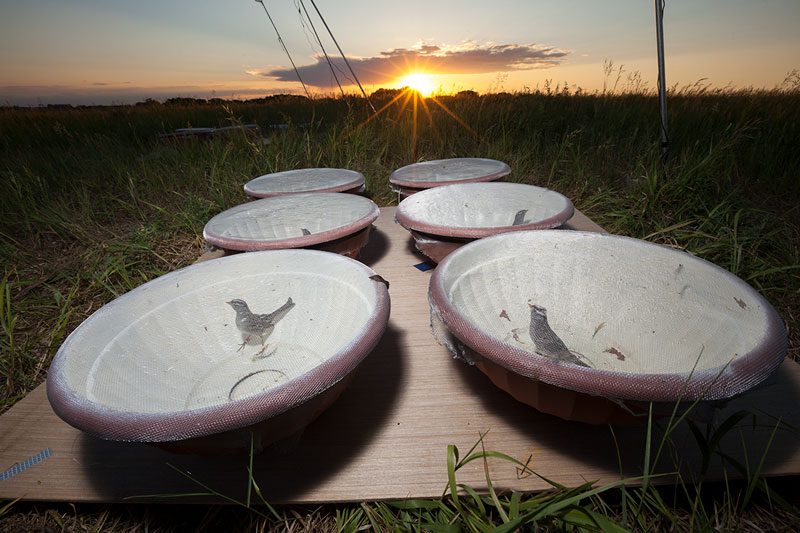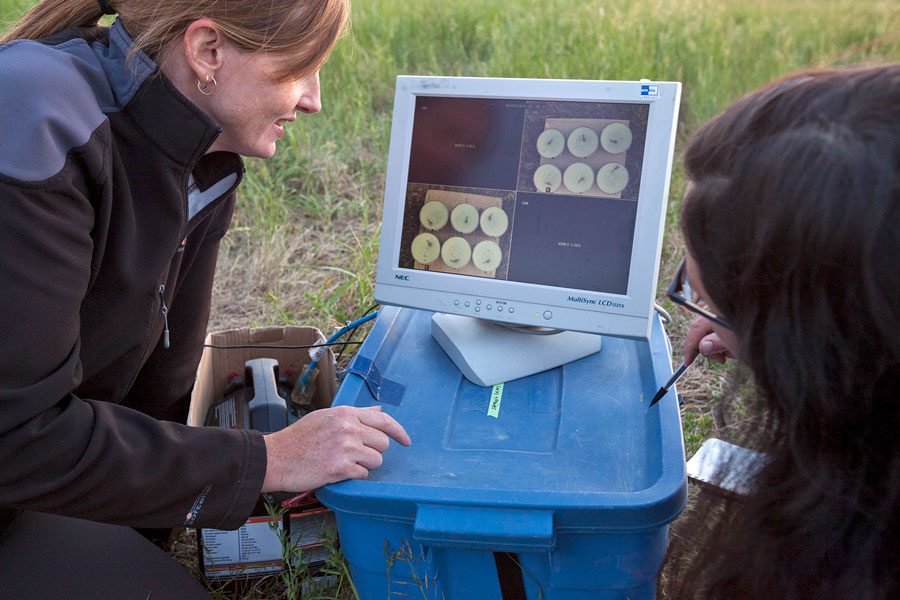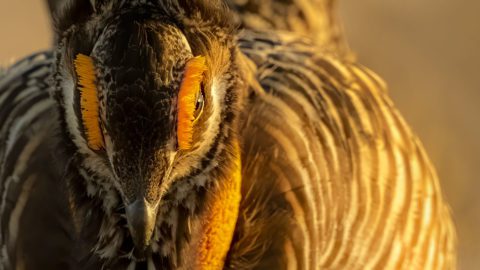“Neonic” Pesticides Interfere With Sparrow Migration, Studies Show
By Rebecca Heisman and Winny Sun, with additional reporting by Marc Devokaitis
March 30, 2020
From the Spring 2020 issue of Living Bird magazine. Subscribe now.
Collapsing bee populations have made headlines in recent years, and scientists have identified one cause as a class of pesticides known as neonicotinoids. Now a growing body of research is showing that it isn’t just the bees that are at risk. It’s the birds, too.
In two recent studies, exposure to neonicotinoids caused migrating White-crowned Sparrows to lose weight, lose their sense of direction, and delay their migration. The work, by Margaret Eng and Christy Morrissey, both at the University of Saskatchewan, provides the first direct experimental evidence that these pesticides can disturb bird migration.
Neonicotinoids (often called “neonics”) were first introduced in the 1990s and promoted as a safer alternative to an older class of pesticides called organophosphates. Today, they’re the most-used type of pesticide worldwide. Neonics paralyze and kill insects by binding to their nerve receptors. One of their selling points is that the pesticide can be pre-coated on crop seeds before planting, so neonics can be taken up into plant tissues as the plant grows, reducing or eliminating the need for applications such as crop dusting in the field.
Past research has found correlations between bird population declines and increasing levels of neonic contamination in waterways near agricultural areas. But Eng and Morrissey wanted to see if direct exposure to neonics, at levels that could easily be encountered by wild birds, would have any sublethal effects.

Such sublethal pesticide exposures (which don’t kill birds outright, but harm bird behavior or physiology) have devastated bird populations in the past. DDT infamously decimated Bald Eagle, Osprey, and Brown Pelican populations not because it made them drop dead, but because the pesticide caused them to lay eggs with thin, weak shells. These eggs would rarely hatch, resulting in widespread nesting failures and drastic population declines.
For the laboratory study, published in Scientific Reports in 2017, the team measured how 51 White-crowned Sparrows captured in Saskatchewan during spring migration reacted to exposure to imidacloprid—the most widely used neonicotinoid.
The researchers exposed the sparrows to a pesticide dose equal to eating around four imidacloprid-treated canola seeds—a realistic scenario considering canola fields can be spring migration stopover sites, and spring planting season is a prime time for potential bird exposure to treated seed.
Within a day of neonic exposure, the captive sparrows slowed their eating. Three days after exposure, the birds had lost up to a quarter of their body mass. When researchers tested the birds’ orientation for spring migration, they had lost their ability to find north. The sparrows recovered their sense of direction after two weeks, but that’s a long delay during the critical spring rush toward the breeding grounds.
“Migration delays can carry over to affect survival,” Eng said. “The timing of birds’ arrival on their breeding grounds and the condition that they’re in when they get there can have significant implications for their reproductive success.”

As a follow-up to their lab experiments, Eng and Morrissey designed a field study, published in Science in September 2019, to find out how neonic exposure might affect bird migration in the wild. Working from a site in Ontario, Eng and Morrissey captured White-crowned Sparrows and outfitted them with tiny geolocators called nanotags. The scientists then planned to expose the sparrows to a dose of neonics, and then set them free. The nanotag-carrying birds could then be tracked on spring migration via a radio telemetry network known as Motus with 100 receiver towers scattered across the province.
But the scientists made a startling find before their research even got started: Of the 36 White-crowned Sparrows captured in the wild to begin the study, 28 already had detectable neonic levels in their blood before dosing. In other words, in a random small sample, nearly 80% of wild White-crowned Sparrows were already flying around with these chemicals in their bloodstream.
The birds in the field experiments exhibited similar symptoms to those in the lab study. The field-study sparrows appeared to lose their appetite, and some birds shed as much as 6% of their body mass within just six hours.
After release, the dosed birds recorded unusually long stopover periods on their continued spring migration (an average of 3.5 days longer than the control group). Based on the results from the lab, Eng suspects lack of food consumption or neonic intoxication.
“It’s the first time that we have been able to track pesticide exposure in free-ranging birds at the landscape scale,” Eng said.
White-crowned Sparrows are just one of many bird species that make migratory rest stops in agricultural areas. And canola fields are only one avenue of exposure; many birds make pit stops in corn and soybean fields as well. A 2015 study published in Environmental Science and Technology showed that as of 2011, 80% of the corn fields and over one-third of the soybean fields in the U.S. were planted with seeds treated with a neonicotinoid coat. Altogether, the researchers estimated that 42 million hectares, or about 57% of the total area of cropland in the U.S., were planted with treated seeds.
Unfortunately, the birds most likely to suffer the direct effects of neonic exposure in agricultural areas are being hit hard by population declines. According to a 2019 study published in the journal Science, North America’s grassland bird populations have dropped by 53% since 1970.
Following the release of Eng and Morrissey’s Science study in September, David Fischer, the chief scientist for pollinator safety at Bayer CropScience (a primary manufacturer of imidacloprid), was quoted by the Associated Press as saying that the field experiments did not accurately represent the level of neonic exposure birds experience in the wild.
“There’s no support for thinking neonicotinoids are responsible for songbird decline, which they sort of hint at in the study,” Fischer told the AP.
Morrissey, the study’s coauthor, said in response: “The amount we gave these birds was equivalent to a small bird eating less than a single treated corn seed or just a few canola or cereal seeds. In fact, we estimate the doses would be less than 1% of their daily diet. For context, a songbird can eat hundreds of seeds in a day.
“There is no basis for Bayer’s statement that the results are not representing real-world exposures.”
Rebecca Heisman is a freelance science writer and a communications specialist for the American Ornithological Society. Winny Sun was a student editorial assistant for Living Bird in summer 2019; her work on this story was made possible by the Cornell Lab of Ornithology Science Communication Fund, with support from Jay Branegan (Cornell ’72) and Stefania Pittaluga. Marc Devokaitis is associate editor for Living Bird.

All About Birds
is a free resource
Available for everyone,
funded by donors like you
American Kestrel by Blair Dudeck / Macaulay Library



